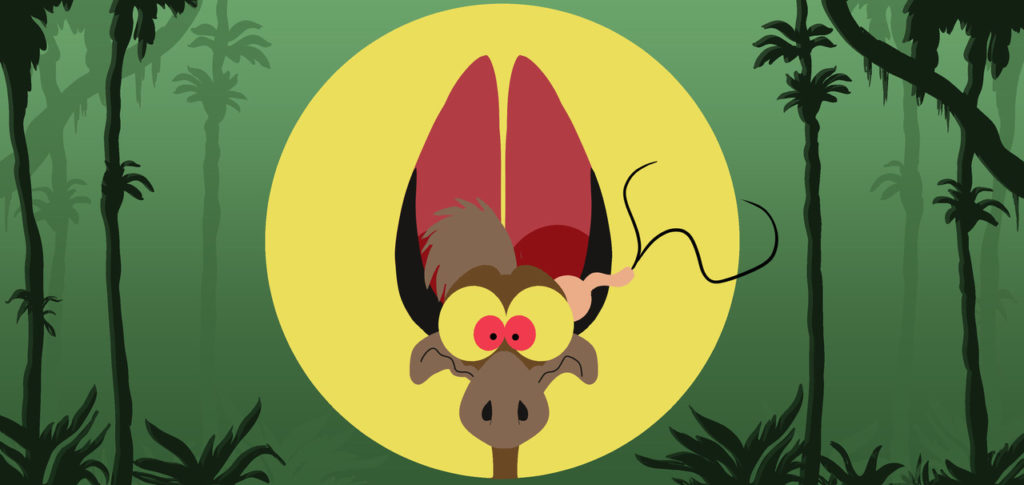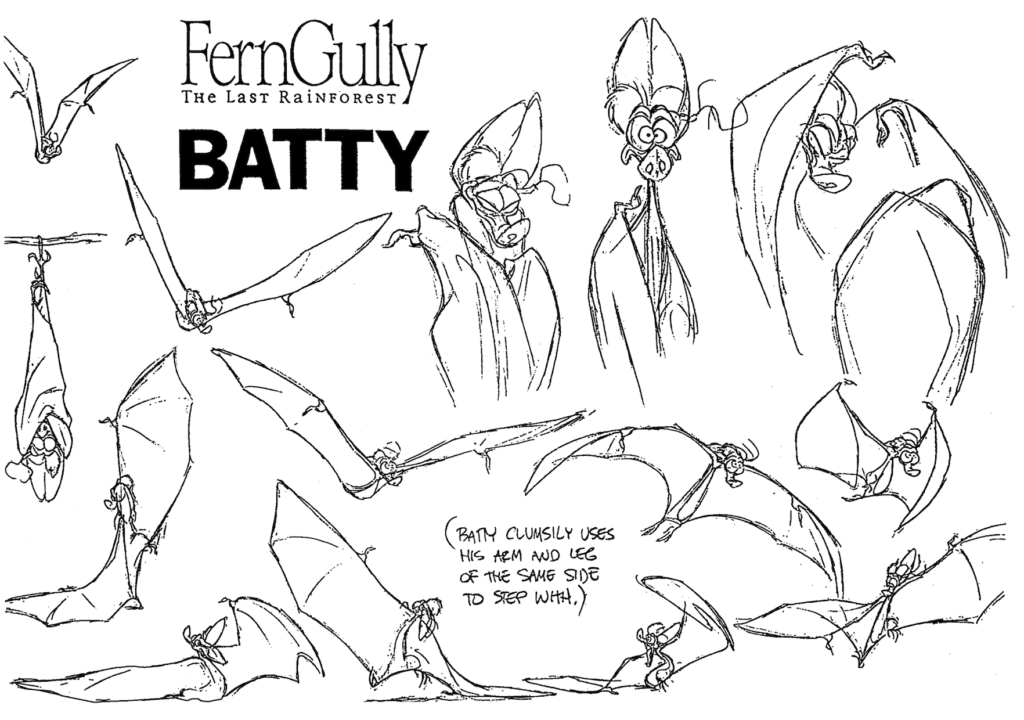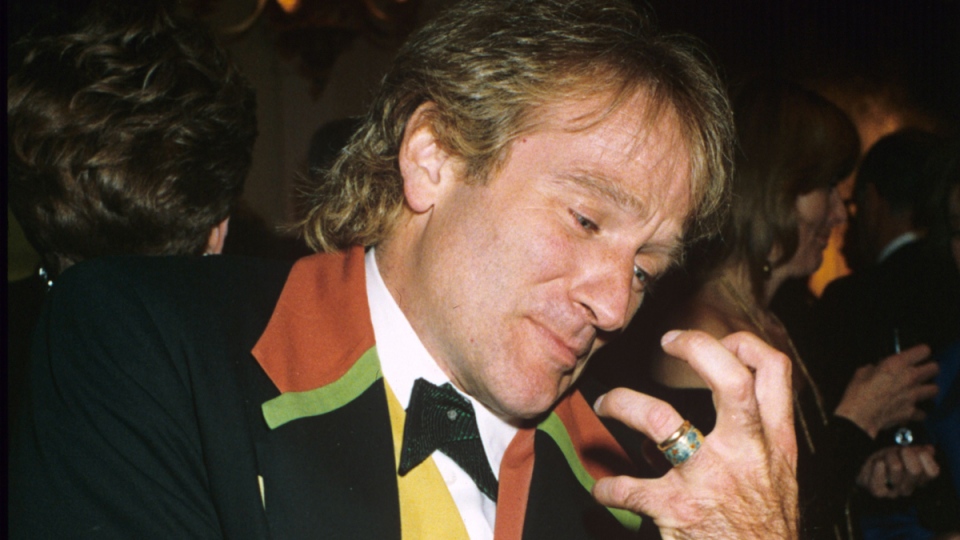Last summer, the documentarian Marina Zenovich joined some friends for a beachside lunch in Saint Tropez. She was on holiday from editing her biopic doc Robin Williams: Come Inside My Mind, which airs on HBO July 16. The crudité basket arrived, and I—sun- and rosé-brave—blurted “Marina! Williams’ best animated container was Batty, not Genie.” Zenovich dragged endive through vinaigrette. “Who’s Batty?” she asked. And then, with the flawless patience of a master interviewer, she said, “Okay. Tell me.”
This story takes place over a span of eight months in 1992. Robin Williams appeared in theaters for two animated feature films. First, he lent his voice to a lab-addled fruit bat in the indie environmental flick FernGully, about a tribe of fairies living in endangered nature; then, he voiced a high-octane jinn on retainer for three wishes in the Disney blockbuster Aladdin. The characters shared traits, namely a deep-seated distrust of people. People had experimented on him until his sonar failed in the one case, and enslaved him on a wish-fulfillment circuit in the other. Where Batty Koda’s head sprouted wires, Genie had passed ten thousand years in a common oil lamp because humans, it seemed, were real jerks. “They’re numb from the brain down,” Batty claims.
“That was always a part of Robin’s comedy repertoire—how stupid and fucked up humans beings are,” Wayne Young, the producer of both Crocodile Dundee and FernGully, told me. FernGully’s Zak, a teenage logger, and the titular Aladdin, a teenage sneak thief, were supposed to be exceptional mensches. They held little charm for us kids. What we did notice—as did the adults who reviewed the movies—was that Williams’ deuteragonists had stolen both shows.
The “bat is by far the picture’s most memorable creation, chiefly because, well, he’s Robin Williams in bat drag,” Hal Hinson wrote at the Washington Post. Entertainment Weekly told readers that FernGully was “worth renting … just for Williams’ riffs about horrible humans.” Not a box-office hit, nor a critical success, FernGully would do really well on home video—selling some 2.5 million copies for about $50 million. It now has a cult status as the film that introduced many eighties babies to ecocide: a millennial Silent Spring.
The big blue lug of Aladdin was a different story. Disney’s wizardly studio chief Jeffrey Katzenberg had failed to pressure Williams out of voicing two animated characters at the same time. (“Who does he think he is? It’s my voice!” stormed Williams.) He had even tried to derail Kroyer Films—the upstart behind FernGully—by buying out their rented workspace, a former brewery in the Valley, from underneath them. Around Aladdin’s release, Katzenberg pointed up the sky-colored shape-shifter as a supreme Williams vehicle, saying, “Until now, we have been entertained by hearing the genius of how Robin’s mind works. Now … we get to see him thinking.” As Genie, Williams was an “elastic miracle,” the New York Times agreed. “The Genie mutates into dozens of variations on himself. Williams’ spieling and spritzing acquires a lickety-split clarity,” The New Yorker wrote. The script of Aladdin morphed under the influence of Williams’s recording booth ad libs, until Genie was less a supporting role than a title character. Genie went down in animation history. “But after [FernGully] came out,” Young remembered, “Katzenberg called me and said something along the lines of, ‘You made the best non-Disney film, ever.’”
“He’s famous for Genie,” FernGully’s director Bill Kroyer admitted. “A lot of people forget that he did Batty, and that he did Batty first.” Like the laboratory and the lamp, neither script could hold him. “We rarely ended up using the exact scripted stuff,” Kroyer said. “When Robin started riffing, he would come up with something that would be just that much funnier, that much more impactful. I sat in amazement. It worked the same every scene: he would absorb the shot, do the script, and then launch into variations.”
“Writing for Williams was like writing for a jazz musician,” said FernGully’s screenwriter Jim Cox. “In the film, there is a scene when Batty snatches up Zak before the Leveler runs him over, but Zak wants to get to the machine to stop it, and he says something like, ‘Take me there, Batty!’ And Batty flies him in. In the recording studio I told Robin, ‘Just do every military charge cliché thing you can think of.’ He did ten nonstop minutes. It was like seeing a virtuoso musician spin out a solo—it built in this way that was just ecstatic. At the end, it was like watching someone go to the edge of sanity. His voice became tiny, and he said, ‘Somebody pull me back! Pull me back!’ It was like he was so far out, he didn’t know how to get back to reality.”
Genie’s development has been well-documented, Batty’s not at all. The relationship between the two voice overs was not remarked on in 1992 or in 2014, when the comic died. Aladdin earned more than FernGully, the animation historian Charles Solomon pointed out. “More people have seen it.” Genie is a rounder character, he said: “His relationship with Aladdin is second only to Aladdin and Jasmine. You believe the Genie and Aladdin genuinely care for each other.” And while FernGully’s animation is “certainly competent,” he explained, it’s “not extraordinary.” Solomon told me that he remembered when he saw a preview of Aladdin: “I thought, ‘At last.’” Genie could shift as fast visually as Williams could verbally.
FernGully sprang from the conscious of an Australian woman named Diana Young, Wayne Young’s then-wife. Diana and Wayne and their children had hopped from Mykonos to Ibiza to Seychelles to Bali. Then, in the late seventies, the Youngs settled on Australia’s east coast—twenty miles outside of the surfing village Byron Bay. It is an area lush with old-growth rainforest, which once stretched from the hills to the ocean. “The first major protests to stop the logging of the last forests happened right here,” said Wayne. “It’s feminine land,” he added, referring to its verdant fertility. “The continent is ninety odd percent in permanent drought, but this is subtropical.” They lived on a 135-acre estate that rolled to a gully with ferns, figs, fungi, eucalyptus, platypuses, kookaburras, kingfishers, goannas, koalas, wallabies, and fruit bats. “I was living in this magical realm and watching its destruction and going to demonstrations,” Diana told me recently. After dropping her sons at school, she sometimes took a sandwich and a notebook and sit by the watering hole for hours, drafting accounts of a fairy heartland under threat. She never published the tales, but at night she told them to the boys, Nick and Stu.
Batty existed in Diana’s bedtime story, which Cox remembers coming to him as a batch of Xeroxed papers. It was she who supplied the key detail: that the scientists had drilled an electrode into the animal’s head. “He was thus an insane fruit bat, basically the comic relief,” Cox tells me.
Cox often saw Robin Williams at Los Angeles comedy clubs like the Laugh Factory, where the Juilliard alumnus would show up unannounced to open mics. Cox wrote Batty with Williams in mind. In Cox’s treatment, the electrode “was like an antenna in his brain that streamed TV and popular culture and ran it through his consciousness.” Whenever the bat’s wires sparked, he would become abruptly possessed of Ricky Ricardo or Shakespeare’s Julius Caesar. He would change channels to Star Trek or All About Eve. He’d quote the scientists. (“Pass the probe.”) “Yo!” he raps in the film. “My name is Batty. The logic is erratic.” If there was ever a just-so story for Williams’ brand of hyperactive improvisational impersonation, this was probably it.
“Batty’s the metaphor, you know?” Kroyer said. “He’s the metaphor for nature mistakenly, or not mistakenly, damaged by human interference. He is so unbelievably sympathetic. And there was a wounded animal like Batty inside Williams.”
Zenovich thought so too. “He responded—he inhabited,” she told me. “I’m more of an actor than a comedian,” Williams says in her doc. “I don’t tell jokes—I just use characters as a vehicle for me. I seldom just talk as myself.” Zenovich continued: “He was something in that recording room—off-stage, off-camera, and pretty well off-script—that was desperate to come out.”
Robin in the rainforest may have been overlooked, but the work remains worthy of canonization. In the movie, when Batty trembles, his wings hang around him like a security blanket; in instances of chutzpah, they transform almost into a cape. He’s fearful/crazed/tragic and sharp-tongued; also, tenderhearted and heroic. Who cares if the bat is funnier than the jinn? He’s sadder. More fractured. More Williams.
Chantel Tattoli is a freelance journalist. She’s contributed to the New York Times Magazine, VanityFair.com, the Los Angeles Review of Books, and Orion, and is at work on a cultural biography of Copenhagen’s statue of the Little Mermaid.
from The Paris Review https://ift.tt/2uAwOVN



Comments
Post a Comment